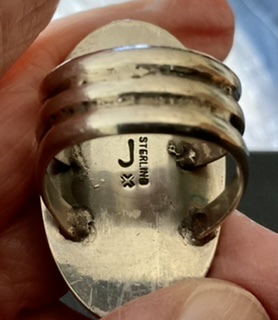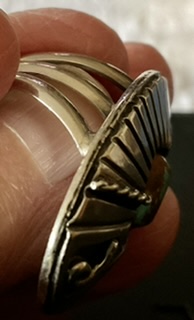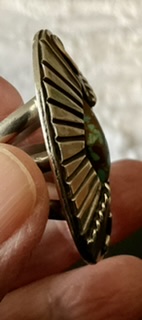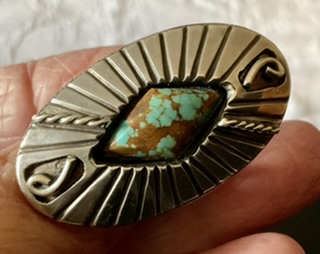I purchased this ring at a fundraiser auction and am trying to find out a little more about it. It appears to be overlay with turquoise set down into the center. It is hallmarked with a J and what looks like a double walled X. I have had no luck identifying the symbol but I did read about Julia Cadman and it sounds like a she might be a possibility.
I’m curious about the artist, the technique and the age. An approximate price would be nice too. Thanks for your help.





So I will try testing out my newly acquired knowledge from this forum regarding a previous post on my cuff. Your ring looks like a shadow box piece, which I think means it’s made in the hollow form process?
I really like shadow box pieces, so of course I love your ring!
I think that this would also qualify as a type of shadowbox. There is a smooth bezel around the turquoise. Now maybe someone will chime in and tell us how the turquoise was set. Was it set before or after the top was overlayed? Most other shadowbox that I’ve seen has more open space around the stone.
The stone is always set after the ring is made. For a ring like this with a narrow gap around the bezel, I’d use a knife blade as a burnisher and maybe some super glue or epoxy under the stone to make sure it stays put.
Thank you for the explanation; I had also wondered when in the process the stone was added. Was hoping you’d chime in!
Thanks for answering my question. I thought that the turquoise needed to be last because of the heat from soldering but it looks like a pretty tight place to work.
Do you have any idea of age on this one?
Congratulations on your winning bid! A beautiful ring and you helped out the fundraiser too! Wear it in good health.
Thank you. I’m glad I got to help and I’m sure I will get much enjoyment from wearing the ring.
Could have been made anytime from the 70s until the last few years. There are a couple of unusual elements like the triple 1/2 round wire shank, flattened twist wire soldered diagonally on opposing sides of the radial stamp work, and the individually shadowboxed 1/2 round flourishes which look like non-Native work, or at least non commercial. It also looks like there are two back plates used with the thinner (28 gauge) being soldered first, and then soldered on to the heavier (22 gauge) back plate. To my eye, it looks like whoever made this was experimenting a bit. It’s a nice piece, unusual and attractive.
Thank you for the explanation. I had noticed the partially open spaces along the edge of the ring. Now I understand why. I also like unique and beautiful so I got lucky. Maybe I’ll manage to identify the hallmark one of these days. I appreciate you sharing your knowledge.